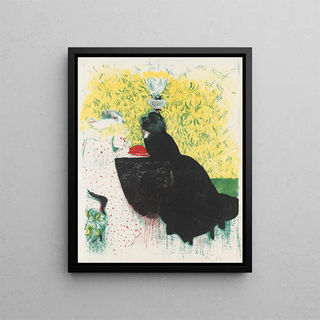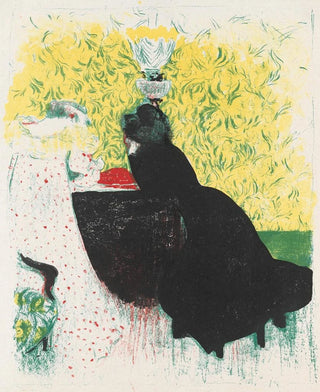Art print | The two beautiful sisters - Édouard Vuillard Source: Reproduction | Les deux belles-sœurs - Édouard Vuillard


View from behind

Frame (optional)
Les deux belles-sœurs - Édouard Vuillard – Captivating Introduction
In the vibrant universe of art, some works manage to capture the essence of human relationships with striking delicacy. "Les deux belles-sœurs" by Édouard Vuillard falls into this category, offering an intimate glimpse into daily life at the end of the 19th century. This painting, imbued with tenderness, highlights the silent complicity between two women while revealing the richness of human emotions. The scene, bathed in soft, warm light, invites the viewer to immerse themselves in their world, to feel the tenderness of their exchanges and the depth of their bond. It is a piece that transcends mere decor to become a mirror of a time, a culture, and a sensibility.
Style and uniqueness of the work
Vuillard's style is distinguished by its intimate approach and mastery of colors. In "Les deux belles-sœurs," he uses subtle tones that evoke the warmth of a home, while textile patterns, omnipresent, reflect his interest in everyday details. The composition is carefully orchestrated, with each element responding harmoniously. The figures of the two women, though static, seem to vibrate with silent energy, as if time has stopped to capture a precious moment. Vuillard, a member of the nabi movement, moves away from academic conventions to explore more personal and introspective themes. This work, both simple and complex, reveals a rich inner world, where every glance, every gesture, tells a story. Thus, the artist manages to transcend the banal to offer a poetic vision of life.
The artist and his influence
Édouard Vuillard, an emblematic figure of the nabi movement, knew how to mark his era with an innovative approach to painting. Born in 1868 in Cuiseaux, he was influenced by the works of his contemporaries, notably Pierre Bonnard and Paul Sérusier. Together, they sought to reinvent painting by moving away from traditional realism to explore subjectivity and the intimacy of everyday scenes. Vuillard, thanks to his talent for capturing fleeting moments, left an indelible mark in the world of art.

Matte finish

View from behind

Frame (optional)
Les deux belles-sœurs - Édouard Vuillard – Captivating Introduction
In the vibrant universe of art, some works manage to capture the essence of human relationships with striking delicacy. "Les deux belles-sœurs" by Édouard Vuillard falls into this category, offering an intimate glimpse into daily life at the end of the 19th century. This painting, imbued with tenderness, highlights the silent complicity between two women while revealing the richness of human emotions. The scene, bathed in soft, warm light, invites the viewer to immerse themselves in their world, to feel the tenderness of their exchanges and the depth of their bond. It is a piece that transcends mere decor to become a mirror of a time, a culture, and a sensibility.
Style and uniqueness of the work
Vuillard's style is distinguished by its intimate approach and mastery of colors. In "Les deux belles-sœurs," he uses subtle tones that evoke the warmth of a home, while textile patterns, omnipresent, reflect his interest in everyday details. The composition is carefully orchestrated, with each element responding harmoniously. The figures of the two women, though static, seem to vibrate with silent energy, as if time has stopped to capture a precious moment. Vuillard, a member of the nabi movement, moves away from academic conventions to explore more personal and introspective themes. This work, both simple and complex, reveals a rich inner world, where every glance, every gesture, tells a story. Thus, the artist manages to transcend the banal to offer a poetic vision of life.
The artist and his influence
Édouard Vuillard, an emblematic figure of the nabi movement, knew how to mark his era with an innovative approach to painting. Born in 1868 in Cuiseaux, he was influenced by the works of his contemporaries, notably Pierre Bonnard and Paul Sérusier. Together, they sought to reinvent painting by moving away from traditional realism to explore subjectivity and the intimacy of everyday scenes. Vuillard, thanks to his talent for capturing fleeting moments, left an indelible mark in the world of art.






